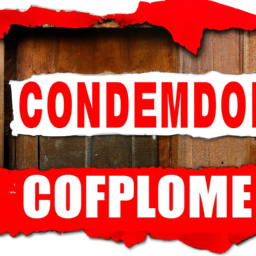Learn the CMA real estate meaning and its importance in the market. Discover the process, components, benefits, limitations, and compare it with appraisal and BPO. Explore the world of CMA software.
Condemnation Property

In the realm of real estate mortgage education, the concept of “Condemnation Property” emerges as a significant component. This term refers to a property that is acquired by a government entity through a process called condemnation, usually for public use or benefit. Understanding the intricacies of condemnation property is crucial for real estate professionals seeking comprehensive knowledge in this field. By delving into the specifics of condemnation property, one can gain valuable insights into the legal and financial aspects associated with such properties, ultimately enhancing their expertise in the mortgage industry.
What is Condemnation Property?
Definition
Condemnation property refers to real estate that is taken or acquired by the government through the legal process of condemnation. This process allows the government to acquire privately owned property for public use or public safety purposes. Condemnation can only occur through specific legal procedures and requires the government to provide fair compensation to the property owner.
Purpose
The purpose of condemnation property is to serve the public interest by enabling the government to acquire land or property that is essential for the welfare and progress of the community. This may include acquiring land for the construction of public projects such as highways, schools, parks, or other types of infrastructure. Condemnation property also allows the government to address public safety concerns by acquiring dilapidated or hazardous properties that pose a risk to the community.
Process
The condemnation process involves several steps that must be followed in order to lawfully acquire property. It begins with the government identifying a specific property that is necessary for a public purpose or public safety. The government then files a lawsuit against the property owner, initiating the condemnation proceedings. The property owner is notified of the government’s intention and has the right to contest the condemnation and seek just compensation. If an agreement cannot be reached through negotiation, the case proceeds to trial, where a judge or jury determines the fair compensation to be paid to the property owner.
Reasons for Condemnation
Public Safety
One of the primary reasons for condemnation is to address public safety concerns. When a property is deemed unsafe, uninhabitable, or poses a risk to the surrounding community, the government may exercise its power of condemnation to acquire and demolish the property. This ensures the protection of public health and safety and prevents further harm or potential disasters.
Public Use
Condemnation may also occur when the government needs land or property for public use. This can include acquiring land for the construction of public infrastructure such as roads, bridges, airports, or public facilities like schools, hospitals, or government buildings. The government has the authority to use eminent domain to acquire the necessary property, as long as it is determined to be in the best interest of the public.
Economic Development
Economic development is another reason for the condemnation of property. Governments may exercise their power of condemnation to acquire properties in blighted areas or underutilized land for redevelopment purposes. By acquiring and improving these properties, the government can stimulate economic growth, create jobs, and revitalize a community.
Legal Considerations
Just Compensation
The Fifth Amendment to the United States Constitution requires the government to provide just compensation when acquiring private property through condemnation. Just compensation is the fair market value of the property at the time of the taking, including any damages or loss suffered by the property owner as a result of the condemnation. The property owner is entitled to receive a fair and reasonable amount for their property, ensuring that they are not financially disadvantaged by the acquisition.
Due Process
In the condemnation process, the property owner is entitled to due process. This means that they have the right to be notified of the government’s intention to condemn their property and the opportunity to be heard and present their case. Due process ensures that the property owner is treated fairly and has the opportunity to contest the condemnation if they believe it is unjust or if they disagree with the offered compensation.
Eminent Domain
Eminent domain is the legal authority by which the government can acquire private property for public use. It is an inherent power of the government and is often exercised in conjunction with the condemnation process. Eminent domain allows the government to take ownership of the property, while condemnation governs the legal process and procedures by which the property is acquired.
Condemnation vs. Eminent Domain
Differences
While condemnation and eminent domain are closely related, there are differences between the two. Condemnation refers to the legal process through which the government acquires property, while eminent domain is the authority that grants the government the power to take private property for public use. In other words, condemnation is the procedural aspect, while eminent domain is the underlying power.
Similarities
Both condemnation and eminent domain involve the government’s acquisition of private property. They both require the government to provide just compensation to the property owner and ensure that due process is followed. Both condemnation and eminent domain are intended to serve the public interest by enabling the government to secure property for public use or public safety.
Initiating the Condemnation Process
Government Authority
The condemnation process can only be initiated by a government entity or agency with the authority to exercise the power of eminent domain. This authority may be granted to federal, state, or local government bodies, depending on the jurisdiction. The government entity must have a valid reason for acquiring the property and must demonstrate that it is for a public purpose or public safety.
Notice to Property Owner
Once the government has determined the need to condemn a property, it is required to provide notice to the property owner. This notice informs the property owner of the government’s intention to acquire their property and includes information about the reason for the condemnation, the rights of the property owner, and the process for contesting the condemnation if desired. The notice also includes details about the proposed compensation and any other relevant information.
Negotiations
Following the notice, the government and the property owner may engage in negotiations to reach an agreement on the terms of the condemnation and the compensation to be paid to the property owner. These negotiations may involve appraisals, assessments of the property’s value, and other factors that determine the fair compensation. If an agreement cannot be reached through negotiation, the case may proceed to trial.
Rights of the Property Owner
Right to Contest
The property owner has the right to contest the condemnation if they believe it is unjust or if they disagree with the compensation offered by the government. This allows the property owner to present their case and arguments before a judge or jury. In contesting the condemnation, the property owner can challenge the necessity of the acquisition, the amount of compensation offered, or any other aspect of the condemnation process.
Right to Representation
The property owner also has the right to legal representation throughout the condemnation process. This ensures that their rights are protected and that they have the necessary expertise and guidance to navigate the legal proceedings. Having legal representation can help the property owner present their case effectively and negotiate for fair compensation.
Condemnation Proceedings
Filing of Lawsuit
If an agreement cannot be reached through negotiations, the government will file a lawsuit against the property owner to initiate the condemnation proceedings. This lawsuit will outline the government’s claim for condemnation, the reasons for the acquisition, and the compensation being offered. The property owner will have an opportunity to respond and present their case in defense of their property.
Expert Appraisal
During condemnation proceedings, expert appraisers may be called upon to determine the fair market value of the property. These appraisers assess various factors such as the property’s condition, location, potential uses, and comparable sales in the area. Their findings play a crucial role in determining the compensation to be paid to the property owner.
Trial
If the condemnation case proceeds to trial, it will be heard by a judge or jury who will evaluate the evidence and arguments presented by both parties. The judge or jury will determine the fair compensation to be awarded to the property owner, taking into account the findings of the expert appraisers, the arguments put forth by the property owner and the government, and any other relevant factors. The decision reached at trial will be final, unless appealed.
Challenges and Defenses
Inadequate Compensation
One of the common challenges raised by property owners in condemnation cases is the claim that the compensation offered by the government is inadequate or does not reflect the fair market value of the property. Property owners may argue that the government has undervalued the property or failed to consider certain factors that would increase its value. In such cases, property owners can present evidence and expert testimonies to support their claim for higher compensation.
Invalid Purpose
Another challenge that property owners may raise is the claim that the condemnation is being carried out for an invalid purpose. For example, if the government is acquiring the property for economic development but there is evidence to suggest that the intended project is not for the public benefit or is a guise for private gain, the property owner may present this argument as a defense against the condemnation.
Procedural Errors
Property owners can also challenge the condemnation process based on procedural errors committed by the government. This can include failure to properly notify the property owner, failure to follow necessary legal procedures, or other violations of due process. Procedural errors can potentially result in the dismissal of the condemnation case or the requirement for the government to restart the process.
Condemnation Process Timeline
Pre-Litigation Phase
The condemnation process typically begins with the identification of the property to be condemned and the evaluation of its necessity for public use or public safety. Once this determination is made, the government will provide notice to the property owner, engaging in negotiations and attempting to reach an agreement on compensation. If an agreement cannot be reached, the process moves to the litigation phase.
Litigation Phase
The litigation phase starts with the government filing a lawsuit against the property owner, formally initiating the condemnation proceedings. This phase involves the presentation of arguments, evidence, and expert appraisals by both parties. If the case proceeds to trial, a judge or jury will hear the case and determine the fair compensation to be paid to the property owner. Once a decision is reached, the post-litigation phase begins.
Post-Litigation Phase
In the post-litigation phase, the court’s decision regarding compensation is implemented. The government is required to pay the awarded compensation to the property owner within a specified time frame. If the property owner is dissatisfied with the decision, they may have the option to appeal, initiating another round of legal proceedings. However, if there are no further challenges, the condemnation process is considered complete.
Impacts of Condemnation on Property Owners
Financial Loss
One of the significant impacts of condemnation on property owners is the potential financial loss. Even with just compensation, property owners may still face a financial burden by having to relocate or find alternative properties. The compensation received may not fully account for the market value of the property or the associated costs of moving, finding a new location, and rebuilding.
Displacement
Condemnation often requires property owners to relocate or vacate their premises. This can be particularly challenging for businesses or families who have established roots in the community. Displacement can disrupt businesses, livelihoods, and personal lives, leading to uncertainty and upheaval.
Emotional Stress
The condemnation process can be emotionally stressful for property owners. Losing one’s property, home, or place of business can be a deeply emotional experience. The uncertainty, the negotiations, and the legal proceedings can cause anxiety, frustration, and a sense of powerlessness. Property owners may also feel a loss of control over their own destiny and the future of their community.
In conclusion, condemnation property is the legal process by which the government can acquire privately owned property for public use or public safety. It involves several steps, including notification to the property owner, negotiations for compensation, and, if necessary, litigation and trial. The property owner has rights, such as the right to contest the condemnation and the right to legal representation. Challenges and defenses can be raised, including inadequate compensation, invalid purpose, and procedural errors. The condemnation process can have significant impacts on property owners, including financial loss, displacement, and emotional stress. Understanding the condemnation process and the rights of property owners is essential for both government entities exercising eminent domain and property owners facing the potential loss of their property.


